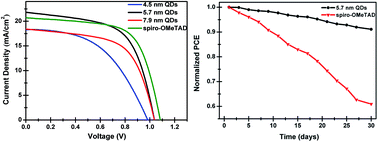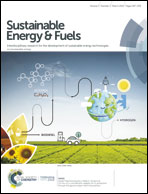Bandgap aligned Cu12Sb4S13 quantum dots as efficient inorganic hole transport materials in planar perovskite solar cells with enhanced stability†
Abstract
With the rapid development of perovskite solar cells (PSCs), it is critical to explore efficient and low-cost inorganic hole transport materials (HTMs) to solve the instability issue of the traditional organic HTM spiro-OMeTAD. Herein, Cu12Sb4S13 quantum dots (QDs) are applied as inorganic HTMs in n–i–p planar PSCs, the bandgap aligned the QDs is achieved by the modulation of the QD size to accelerate hole transport from the perovskite layer to QDs, and a power conversion efficiency (PCE) of 14.13% is achieved for 5.7 nm sized QDs. IPCE and UV-vis spectra indicate that the light absorption intensity of Cu12Sb4S13 QD based PSCs is slightly higher than that of the spiro-OMeTAD based one, which enables the enhancement of JSC (21.85 mA cm−2) for PSCs. The excellent hole transport behavior of Cu12Sb4S13 QDs proves that Cu12Sb4S13 QDs may be considered as an efficient and potential candidate of HTMs in PSCs. Moreover, the stability of the Cu12Sb4S13 QD based PSCs is significantly improved compared with that of the spiro-OMeTAD based one due to the high stability of Cu12Sb4S13 QDs and 91% of the initial PCE is retained after 30 days in ambient air.

- This article is part of the themed collection: 2019 Sustainable Energy and Fuels HOT Articles


 Please wait while we load your content...
Please wait while we load your content...